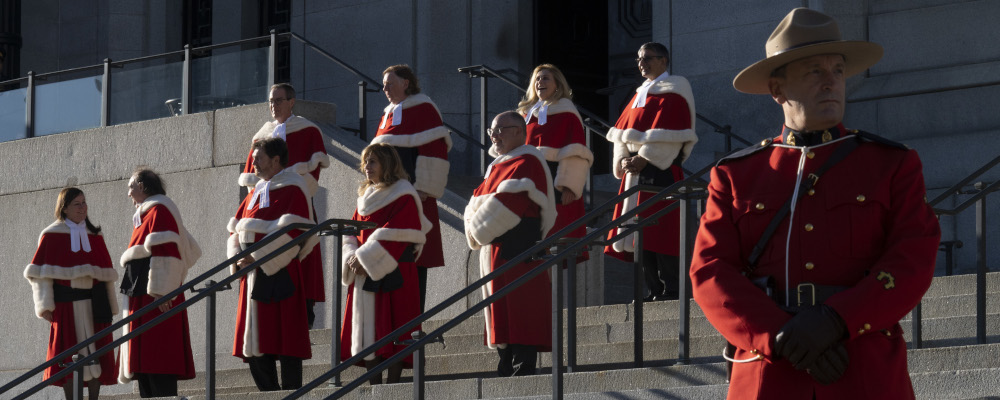Conservative leadership hopefuls, including Pierre Poilievre and Jean Charest, have proposed using the notwithstanding clause to effectively reverse the Supreme Court’s recent decision to invalidate extended parole ineligibility for multiple murderers in R. v. Bissonnette.
Poilievre, Charest, and others rightly see the Bissonnette case as an erroneous decision deserving of a parliamentary response, but the notwithstanding clause is not the best option for responding since the clause’s sunset provisions fit awkwardly with the solemnity of criminal sentencing.
Those difficulties could be avoided by pursuing other more constructive constitutional alternatives that would only employ ordinary statutory powers and yet still achieve most of the policy objectives of the now-invalidated legislation.
First the decision itself. The Harper Government’s 2011 Protecting Canadians by Ending Sentence Discounts for Multiple Murders Act amended the Criminal Code of Canada by allowing sentencing judges the discretion to alter parole eligibility for offenders convicted of multiple murders. In Canada, first degree murder is typically (but not always) “planned and deliberate” murder and it carries a mandatory life sentence with no eligibility for parole until 25 years have been served in prison. It is called a ‘life sentence’ because the state can and will impose some coercive measures on the offender’s freedom for the remainder of their natural life, but it certainly does not guarantee an offender will spend their life in prison.
This is where parole eligibility comes into play: after serving 25 years in prison, and every five years after that, murderers may apply to the Parole Board to be released from prison and serve the remainder of their sentence in the community (typically with significant restrictions). A life sentence with 25-years of parole ineligibility is both a minimum and maximum sentence — it is the only sentence given for first degree murder and no variation was possible until Harper’s legislative change. The mandatory fixed sentence meant that the sentence remained the same regardless of how many murders an offender committed. Recognizing that this pays little respect for the value of each individual victim life, Harper’s legislation allowed judges the option to “stack” the parole ineligibilities consecutively if they deemed it appropriate, allowing judges to impose a life sentence where a multiple murderer would be held in prison for 50 or 75 years (or, theoretically, 100 years or more).
In an opinion written by Chief Justice Richard Wagner, the Court unanimously invalidated the new Criminal Code provision as an infringement of the Charter’s section 12 prohibition of “cruel and unusual treatment or punishment” and found it not justified in a free and democratic society, as per section 1 of the Charter. Chief Justice Wagner’s basic argument is that there is an underlying constitutional imperative to respect human dignity and that requires granting all convicts a “realistic possibility of parole.” Some of Wagner’s rhetoric seems more apt for a sermon than a judicial decision. “The horror of the crimes,” The Chief Justice rules, “does not negate the basic proposition that all human beings carry with them a capacity for rehabilitation.”
Canadians are constitutionally committed, according to the Court, to the “conviction that every individual is capable of repenting and re-entering society.” The Court asserts that this is “one of the fundamental moral values that distinguish Canadian society from the societies of many other nations in the world.”
This moral belief is found nowhere in the text of the constitution, so where does it come from? The Chief Justice concedes that even “absurd” sentences with parole ineligibilities greater than a human life span “could well be popular” but they are unconstitutional because they are “contrary to the fundamental values of Canadian society.” When we speak of the “vilest of criminals” who commit “appalling” crimes, isn’t it possible some Canadians would find a sentence guaranteeing actual imprisonment of more than 25 years appropriate even if, as the Chief Justice puts it, such sentences “presupposes at the time of its imposition, in a definitive and irreversible way, that the offender is beyond redemption and lacks the moral autonomy needed for rehabilitation?”
It is one thing to hold the Chief Justice’s moral position — I have some sympathy for it myself — but it is quite another leap to be so certain of it to preclude the possibility that others may reasonably disagree. One might, for example, think human dignity is better respected by emphasizing accountability and personal responsibility to the point where some choices warrant nothing less than a life behind bars regardless of whether the offender is capable of change. And if Canadians disagree on this central point, why should the Court be the moral arbiter of what is required and not the people’s representatives in Parliament?
The Court’s answer is that the Charter “requires that Parliament leave a door open for rehabilitation, even in cases where this objective is of secondary importance.” There is no evidence that the Charter was ever intended to do such a thing. The requirement that every sentence must recognize the importance of rehabilitation is itself a judicial invention. The legislative guidance given to sentencing judges is clear that rehabilitation is a factor that may be considered an objective of any given sentence, but it is not mandatory. Section 718 of the Criminal Code lists the “purposes” of sentencing and declares a “just sanction” as having one or more of the following objectives: “to assist in rehabilitating offenders” is nestled between other valid objectives, like “to denounce unlawful conduct”, “to deter the offender,” “to separate offenders from society” and “acknowledgment of the harm done to victims or to the community.” Strictly as a matter of statutory interpretation, this would allow a just sentence to be solely based on denunciation and acknowledgment of the harm done to the community without even the slightest nod towards rehabilitation.
Even if every Canadian agreed with the Court’s moral position, however, it is still not clear why any other means of giving offenders some hope of release wouldn’t satisfy its conditions. The Chief Justice needs to repeatedly stress that multiple murders require a realistic chance at parole because there is always the possibility of being granted the royal prerogative of mercy, as exercised by Her Majesty upon the advice of the Minister of Public Safety. So, even in Harper’s supposedly draconian scheme of parole abolishment, the possibility of release always remains. Why does this not satisfy the Chief Justice’s concerns about respecting the human dignity of offenders and inspiring rehabilitation?
The royal prerogative is not a “true sentence review mechanism” in the Chief Justice’s eyes in part because it is used “only exceptionally.” This is a surprising point of criticism because the Bissonnette decision takes care to emphasize that just because there will be a parole review at 25 years that does not mean that those “vilest criminals” will actually be granted parole by the board. The Court’s constitutional demand that multiple murders be given a modicum of hope for release from prison takes on a Goldilocks quality: the Royal Prerogative is not enough hope and we shouldn’t fear that too many multiple murders will see their hopes realized, but a 25-year check in, and every 5 years after that, is the just right amount of hope to inspire rehabilitation and respect human dignity.
I remain unconvinced that the Court’s moral calculus is any better than Parliament’s, especially when one remembers that Parliament’s choice was to leave the precise determination to the sentencing judge who has heard the evidence throughout the trial and directly from those impacted.
The Court has made its judgment though and it has imposed it on us through an interpretation of the Constitution, potentially putting it beyond the reach of an ordinary statutory response. For this reason, some Canadian leaders quickly reached for the notwithstanding clause to restore Parliament’s appropriate leading role in the setting of criminal sentences.
To be sure, using the notwithstanding clause, s.33 of the Charter, to respond to Bissonnette would be entirely legitimate, constitutional, and applicable since the s.12 right against “cruel and unusual treatment and punishment” is explicitly within the scope of rights identified as subject to s.33. The problem with doing so is a principled one related to the clause’s sunset provision: a notwithstanding declaration ceases to have effect five years after it comes into force, and it can only continue with a subsequent re-enactment by the current legislature. This makes it an awkward tool to address criminal sentencing matters since it would make sentences inherently indeterminate or, rather, determined strictly by partisan politics.
Sentences are never fully determinate, of course — as mentioned, they could always be interrupted by the granting of a pardon, for example. But, as a matter of fundamental fairness, we have traditionally adopted rules that asymmetrically benefit the offender if a punishment varies. The constitutional recognition of this fairness is exemplified by s. 11(i) of the Charter, which states that “if the punishment for the offence has been varied between the time of commission and the time of sentencing,” the offender gets “the benefit of the lesser punishment.”
If a new government raises the penalty, the offender gets the older, more lenient sentence; if a new government lowers it, the revised, lighter sentence is imposed. It is true, of course, that this section only applies to two very specific points in time — the commission of the crime and the day of sentencing — and says nothing about post-sentencing variation. Canadian offenders can and have remained in prison for sentences longer than they would have received had they committed their crime later, but this is something to be regretted and s. 11(i) does direct us towards a more just understanding of fairness in sentencing.
With the decision in Bissonnette made retroactive by the Court, offenders who have been sentenced with parole ineligibilities beyond 25 years have already seen their sentences altered to comply with the shorter ineligibility period. If the notwithstanding clause is used now, would we alter those sentences back to the previous period of ineligibility? Not only is this likely to attract some form of further constitutional challenge, but it also begins to seem more like politics and less like justice. One possibility is to draft the notwithstanding clause invocation so that it only affects sentences imposed after its enactment, but then the same issues will arise if and whenever the clause sunsets without reenactment. Remember, a subsequent Parliament would not have to do anything to modify the longer ineligibility (no need to pass the “Leniency for Multiple Murders Act”!) and instead can simply let the provision lapse. The potential for criminal sentences subject to partisan ping-pong will be high if the notwithstanding clause is used.
These logistical concerns are not insurmountable and could be addressed through some clever work of criminal justice administration. Or not, since we have tolerated sentencing disparities in the past, as societal and legal norms changed or as we simply accepted disparities as a function of different outcomes in different jurisdictions. The question is whether we are truly comfortable with such nakedly plain politics substituting for the solemnity and principled seriousness that we normally expect in sentencing policy, where the state is imposing the weighty sanction of taking away the liberty of its citizens. This is not a legal question, but rather a political consideration and one a future Parliament should think carefully about.
Consider this thought experiment: what if Parliament reversed its 1976 decision and reinstated capital punishment for Criminal Code offences. Such a reversal would almost certainly violate the Charter according to the Court’s modern jurisprudence. In United States v. Burns, the Court decided that, “in the absence of exceptional circumstances,” it was unconstitutional to extradite to jurisdictions with the death penalty without assurances it would not be applied; the decision also celebrated Canada’s “international advocacy of the abolition of the death penalty” making it “difficult to avoid the conclusion that in the Canadian view of fundamental justice, capital punishment is unjust and it should be stopped.”
If the Charter does not allow even extradition to face the death penalty, it is highly unlikely domestic capital punishment would be consistent with the Charter as currently understood by the Court. To have its way then, Parliament would have to invoke the notwithstanding clause which would clearly heighten the partisan time calculations and make them truly grotesque: Would we be prepared to impose a death penalty only periodically, when one party or another is in power? Will offenders try to delay their trials in hopes of it lasting longer than the clause’s sunset? Regardless of one’s position on capital punishment itself, making such decisions with literal life-and-death consequences directly dependent on partisan outcomes should give one pause.
If the notwithstanding clause were the only option to respond to Bissonnette, it might be worth bearing the costs of some indeterminate and varying sentences. But there is another option that might pass constitutional muster and partially satisfy some of the original intentions behind the Multiple Murders Act: Parliament could simply allow judges to extend parole ineligibility as part of overall sentencing proportionality. So, instead of the stacked “consecutive” 25-year blocks of parole ineligibility, it might allow judges to lengthen the ineligibility period to 30-years, 40-years, 50-years, as deemed appropriate.
New Zealand, as the Chief Justice notes in his survey of other jurisdictions, does just that: it prescribes a minimum period of parole ineligibility (10 years in most cases, 17 years in certain circumstances) but with no maximum ineligibility period. Some might find this overly reliant on judicial discretion but recall that even Harper’s original Act was always discretionary for sentencing judges; there was no requirement to give a stacked parole ineligibility. A move to increase flexibility would answer the concern that parole ineligibility stacked in 25-year intervals might result in disproportionate sentences (s.718.1 of the Criminal Code requires the sentence to be “proportionate to the gravity of the offence and the degree of responsibility of the offender”).
The trial judge in Bissonnette, for example, found Harper’s legislation to be unconstitutional, but would have altered the scheme to allow for Bissonnette himself to be subject to 40 years of parole ineligibility, instead of the standard 25. Some jurists would find this option more constitutionally palatable than the blunt measure of the original legislation.
Making the ineligibility period subject to judicial discretion would avoid the 200-year and 300-year sentences that could result from multiple consecutive parole ineligibilities and which might remind some Canadians of exaggerated American sentences they have rolled their eyes at in the past. In Bissonnette, the Court described parole ineligibilities beyond any natural lifespan as “so absurd that it would bring the administration of justice into disrepute.”
One might have thought we could trust sentencing judges to not indulge in this excessiveness, and the Chief Justice could only point to an instance where a 24-year-old accused was sentenced to 75 years in prison, but it is an absurdity that Canadian judges might import from their American cousins in the future, I suppose.
By allowing judges to apply parole ineligibility periods more flexibly, a revised statute would present the Supreme Court with another opportunity to consider greater parole ineligibilities without some of the more exacerbating features of the original legislation.
As a more moderate implementation, it would have a better chance of surviving the Court’s constitutional review without invoking the notwithstanding clause. And, if such a reasonable response still did not satisfy the Court, the notwithstanding clause would remain a final viable option. In the meantime, allowing judges to extend parole ineligibility in a flexible manner would provide the means for Parliament to reassert its control over sentencing policy, while also continuing to improve criminal justice sentencing policy rather than simply gainsaying an erroneous judicial decision.
Recommended for You

The Supreme Court’s child porn ruling lays bare the limits of its imaginary idea of justice

The unceded advantage: Alberta and Saskatchewan’s case for tit-for-tat federalism

CBC hired 84 percent racialized, Indigenous, or disabled while having job vacancies for top talent: Internal report

Alberta and the notwithstanding clause: Why the province just used it, and why it was logical to do so



